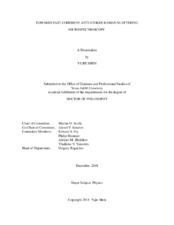| dc.description.abstract | Coherent anti-Stokes Raman scattering (CARS) microspectroscopy is a nonlinear spectroscopy and imaging technique that probes the vibrational and rotational modes of the molecule, enabling chemical-selective microscopy. Over the past years, CARS has found applications in a wide range of fields such as tumor imaging, gas sensing, and flow cytometry. More recently, commercial components and even a microscopic solution dedicated to CARS has become available. This research is devoted to the development of a high-speed, high-sensitivity CARS microspectroscopy system for chemical and biomedical analysis. We started with an easy-to-implement CARS scheme based on ultrafast pulse shaping of single laser beam. We demonstrated an improved setup that achieved higher epi-detection efficiency as compared to earlier experiment, and allowed low-wavenumber Raman band detection below 100 cm. We further simplified our setup by adopting a folded pulse-shaper design, and incorporated the femtosecond adaptive spectroscopic technique (FAST) developed earlier in the group to achieve versatile single-beam CARS detection with significant nonresonant background suppression. Finally, through utilizing the phase information contained in the signal, we devised and implemented an upgraded system by adopting heterodyne detection in the single-beam CARS setup to achieve high speed spectral detection with background suppression. We have also combined spectral detection and pulse shaping in the setup so as to achieve a one-box-solution for CARS measurement.
To further extend the Raman detection range, it is necessary to incorporate means of wavelength extension to achieve broadband excitation. We studied the supercontinuum (SC) generation in large mode area photonic crystal fiber pumped by an industrial picosecond laser. Such an extension unit allowed a simultaneous Raman excitation bandwidth of over 3000 cm?1. We built a multiplex CARS system based on this SC source, and demonstrated its applicability through imaging standard samples. We further constructed a laser-scanning CARS microscope that can provide high spectral resolution and acquisition speed, and showed its capability in 3-dimensional scanning CARS microscopy. In order to boost CARS imaging speed, we also experimented with the wide-field CARS scheme, in which CARS excitation was performed over a large area simultaneously. Using the high-power SC source, we combined the wide-field CARS with multiplex CARS excitation scheme, such that a broad range of Raman modes over a significant spatial region were excited, and CARS image was obtained by applying a corresponding filter. We showed chemical-selective imaging using standard polymer microsphere samples, and demonstrated video-rate CARS microscopy using this setup. | en |


